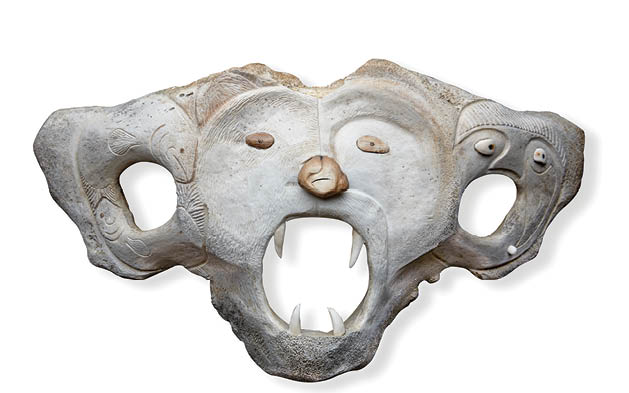Why is an ambitious 26-year-old Minnesotan collecting whalebones, walrus tusks, mammoth tusks and whale baleen? To help fund his business, of course.
Nick Blanco is the owner of Rare Bones, a company that specializes in the marketing and sales of native Shishmaref art that is carved from the fossilized bones of whales, walrus and mastodon/mammoth tusks. An interesting aspect of his business is that the company is not headquartered in Alaska, but in White Bear Lake, where his mother, Lynn Nelson, is the marketing arm of the company and his stepfather, Mike Keeler, is the CFO.
The journey to creating this remarkable company all started back when Blanco was attending college at St. John’s University where he was majoring in economics and minoring in philosophy. In 2008, while studying these two fields, Blanco spent his summer breaks in Alaska working at luxury fishing resorts; he eventually was hired as a deckhand because of his passion for all things fishing. Upon graduating from college, he took a job in Minnesota at a disability law firm, thinking he had found the career he wanted.
“He hated it,” says Keeler. “He was stuck in an office working from a cubicle and he just hated it. He started looking for another job and came across a program that allowed people who didn’t have a master’s degree to teach in Alaska. All he had to do was pass some rigorous tests, [have] a few interviews and commit to a two-year program to become a licensed teacher in 48 states.”

After passing the tests and interviews, Blanco traveled back to Alaska and got a job teaching middle school in Shishmaref, an island in the Chukchi Sea. A lot of the credit for getting the job in Alaska goes back to when he spent his summers working at the fishing resorts, when he got to know the 500 residents that make up the town of Shishmaref.
The natives of Shishmaref live a subsistence hunting culture: If they don’t hunt, they don’t eat. Blanco has had many chances to go hunting with them since he started teaching there, and because of this, he discovered something amazing.
“On these hunts and just through interactions with each other, Nick found out that the natives are discovering fossilized bones and ivory that they create artwork from,” Keeler says. “The pieces are found through simple beachcombing along the shoreline of Shishmaref.”
There are some restrictions in place to make sure the fossils, which can be as numerous as a whole whale skeleton and as many as 40,000 years old, aren’t being exploited.

“As long as you are the original finder of the piece, it is yours,” Blanco says. “However, the harvest of ivory from walrus is legally only to be done by Alaskan native [peoples]. This was brought into law in 1972, and after natives find these relics, they must be carved in order to exchange hands. It is illegal to sell non-carved marine mammal material to non-natives.”
The Shishmaref art of carved pieces that depict the dichotomy between man and nature dates back to 4000 BCE when the Dorset Culture people traveled across the Bering Strait from Siberia. Ever since then, the carving of whalebone, mammoth and walrus tusks and various antlers have had decorative and religious purpose to the natives in Shishmaref. They also create tools such as bow drills, spear tips and jewelry from the rare bones and ivory. The art is elaborate and has anthropomorphic undertones.
Blanco fell in love with this art form and started to collect some artifacts and pieces for himself, but couldn’t resist sharing them with his mother and stepfather. When his parents received some of the pieces of artwork, they fell in love with it, too. Blanco originally wanted to just be a collector of these great pieces of art, but after spending time with the natives hunting, fishing and learning their way of life, he grew to love them and wanted to support them in any way that he could.
According to Blanco, these fossils are part of a troubling reality. Turns out the natives are finding more and more of these fossilized bones due to global warming melting the permafrost in the region. It is taking a great toll on the island of Shishmaref, and if the region continues to melt at its current rate, the natives will be forced to move to the mainland and abandon their way of life in what some say is the not so distant future.
“I decided we should start up a business that helped get the word out about this art form and in turn help support the natives,” Blanco says. “I purchase the art directly from the artists, which is around 40 to 50 carvers and sewers on the island, and that purchase supplements their income greatly. Even the kids often carve and sew for their spending money and some of them are exceptional artists.”

This past December, the business of Rare Bones was officially born. Making a trip back home to Minnesota, Blanco brought some of the jewelry, warm-wear (hats, mittens, etc.) and seal skin to a sponsored show. The attention and interest in the pieces was outstanding, and his parents were happy to help with the merchandise.
“The big thing I noticed was that the women who came to the show loved the warm-wear items that were on display,” Nelson says. “I think they liked these pieces the most because they knew other women were making these in Alaska, as the tradition there is that women sew, and [the women attending the show] could identify with the plight that this was their only way to make money and survive up there. It had meaning to them.”
In April, Blanco and his parents had a booth at the American Craft Council Show in St. Paul to display the art of the Shishmaref residents. The sale of the items went well and now there is a mission for the company; they will continue to sell the items online, and at shows and private parties.
“Now that we know people are interested in these carvings and products,” Nelson says, “we want to find a way to introduce them to the lower 48 states so that more people can see and understand what the [natives] up there are doing, and how the sales of these items go directly back to the community up there so they can survive.”









